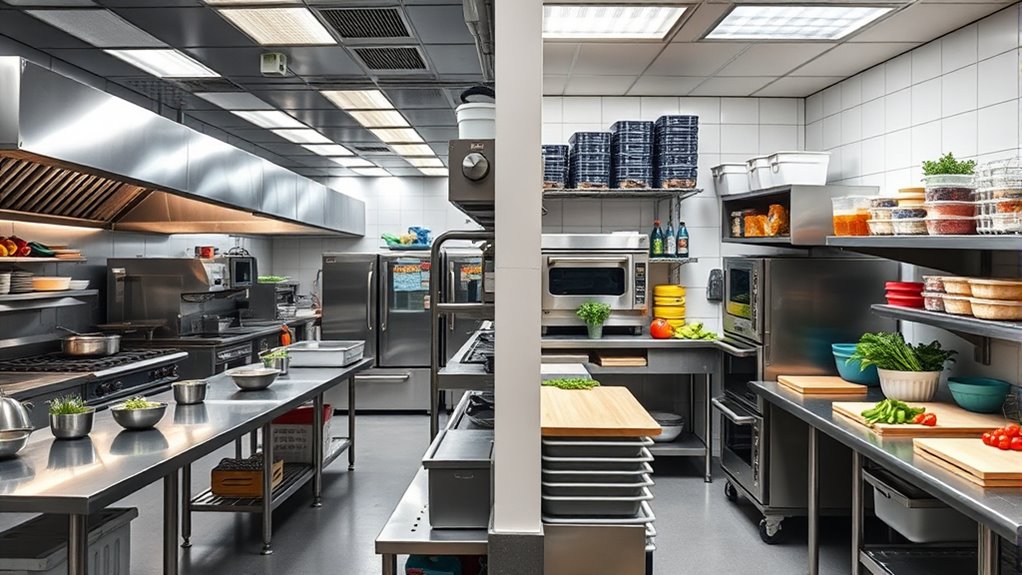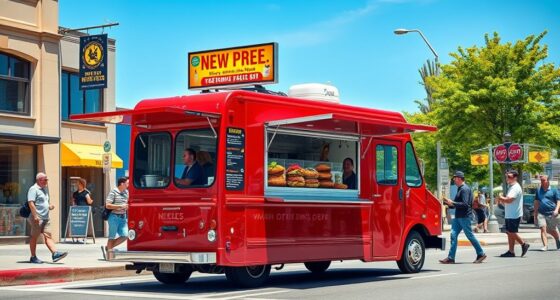Commissary kitchens are large shared facilities used for bulk food prep, storage, and packaging, offering flexible hours and equipment access suited for growing or multiple businesses. Prep kitchens are smaller, specialized spaces designed for initial meal preparation with limited hours and resources. Licensing requirements and costs differ, with commissaries often offering fixed pricing. Understanding these differences helps you choose the right fit for your business needs—continue on to learn more about each option.
Key Takeaways
- Commissary kitchens serve multiple vendors with large-scale storage and production, offering flexible hours and shared equipment; prep kitchens are smaller, dedicated spaces with fixed hours.
- Commissary kitchens prioritize spacious layouts, ventilation, and cybersecurity, while prep kitchens focus on streamlined workflows and easy access to dedicated tools.
- Commissary operations often have fixed pricing models, whereas prep kitchens typically use pay-as-you-go, impacting cost management and flexibility.
- Location influences costs, licensing, and customer reach; commissaries suit larger, multi-product businesses, while prep kitchens are ideal for small or specialized operations.
- Both require compliance with health and safety regulations, but commissaries emphasize bulk storage and compliance for large-scale operations, while prep kitchens focus on efficiency for smaller tasks.
Definitions and Primary Functions
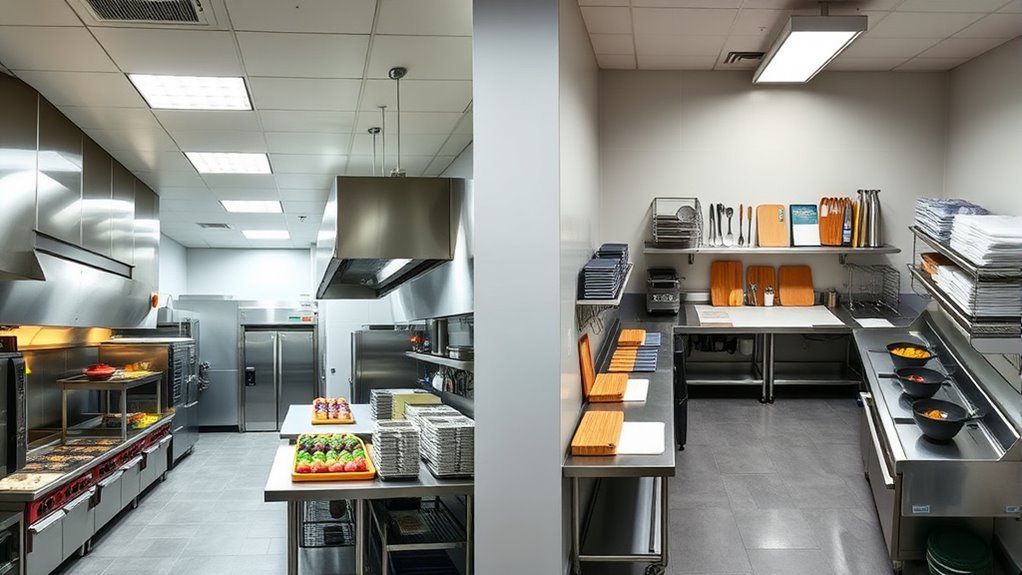
Have you ever wondered what sets commissary kitchens apart from prep kitchens? Commissary kitchens serve as centralized facilities where multiple food vendors or staff prepare, store, and package ingredients and finished products. Their primary function is to streamline operations through efficient storage solutions, ensuring ingredients stay fresh and organized. Staff management is key here, as they coordinate large teams handling bulk food prep and storage. These kitchens typically operate on a larger scale, focusing on food safety, compliance, and cost efficiency. In contrast, prep kitchens are smaller, more specialized spaces where chefs or cooks handle the initial stages of meal preparation. Understanding these differences highlights how commissary kitchens support multiple vendors, while prep kitchens are more focused on specific culinary tasks. Additionally, food safety protocols are especially crucial in commissary kitchens to prevent contamination across multiple vendors. Proper sanitation procedures and adherence to health standards are vital to maintaining hygiene compliance in these environments. Implementing standard operating procedures ensures consistent quality and safety across all operations. Furthermore, cleaning and maintenance are vital for keeping equipment in good working order and preventing cross-contamination. Incorporating temperature control measures is also essential to preserve food quality and safety during storage and handling.
Design and Layout Differences
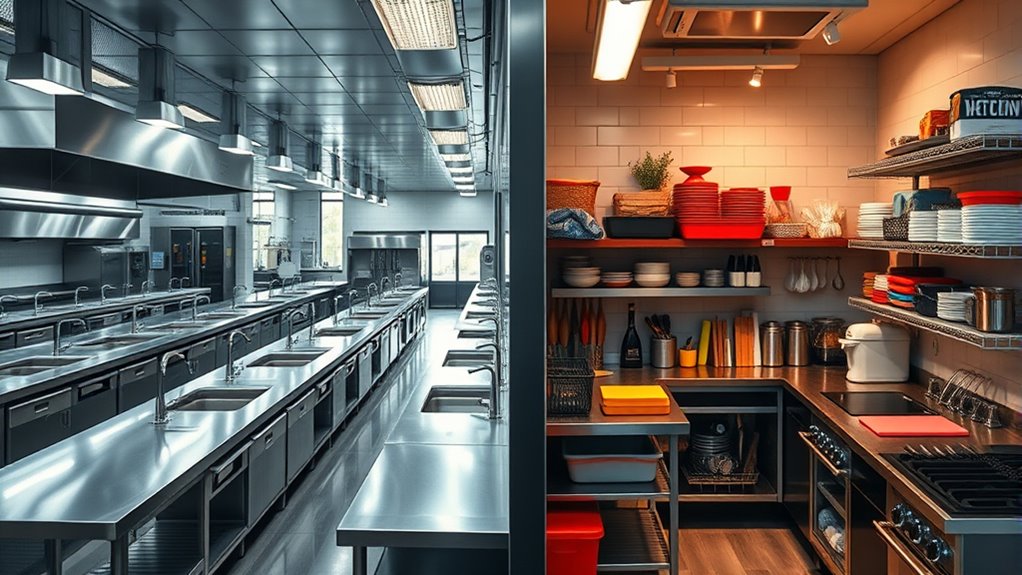
The design and layout of commissary kitchens and prep kitchens reflect their distinct operational needs. Commissary kitchens prioritize efficient storage solutions for bulk ingredients and equipment, with spacious layouts to handle large-scale production. HVAC considerations are critical, ensuring proper ventilation and temperature control for food safety and comfort. Proper ventilation systems are essential for maintaining air quality and controlling odors in these environments. Incorporating food safety protocols ensures compliance with health standards and helps prevent contamination. Additionally, integrating cybersecurity measures can protect sensitive operational data within these facilities. Moreover, understanding hours of operation is vital for scheduling and coordinating deliveries and staff shifts effectively. Prep kitchens, on the other hand, focus on streamlined workflows for smaller batches, with compact storage and easy access to prep stations. Incorporating self-watering plant pots principles can be analogous to maintaining optimal environmental conditions within these kitchens, ensuring proper airflow and moisture control.
Licensing and Regulatory Requirements
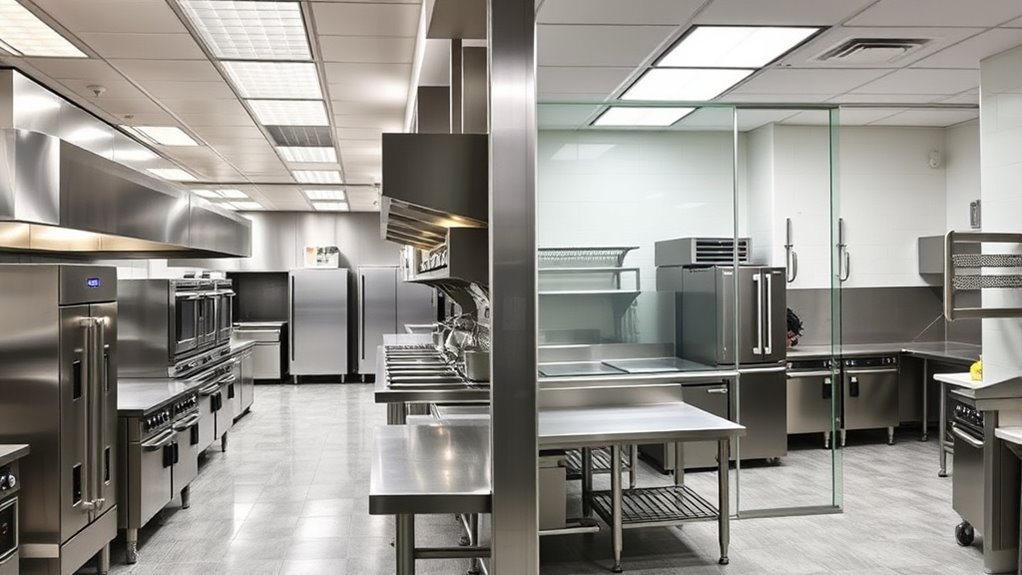
Understanding the licensing and regulatory requirements is key before you can operate a commissary or prep kitchen legally. Food safety is a top priority, and local health departments set strict standards to guarantee your facility meets safety guidelines. You’ll need to navigate licensing processes that vary by location, which often include permits for food handling, sanitation, and business operation. These licenses verify your compliance with health codes and food safety protocols, helping prevent contamination and foodborne illnesses. Being aware of regulatory compliance can help you avoid penalties and ensure your business remains operational. It is also important to stay informed about electric equipment standards, which can influence the types of appliances and tools permitted in your kitchen. Additionally, keeping up with industry trends can help you stay ahead of changing regulations and best practices. Failing to meet licensing requirements can result in fines, shutdowns, or legal trouble. Staying informed about local regulations and licensing updates can help you adapt quickly to new requirements, ensuring continuous compliance. Additionally, understanding the specific divorce process in your state can be crucial if legal issues arise related to business ownership or partnership disputes.
Cost Structures and Payment Models
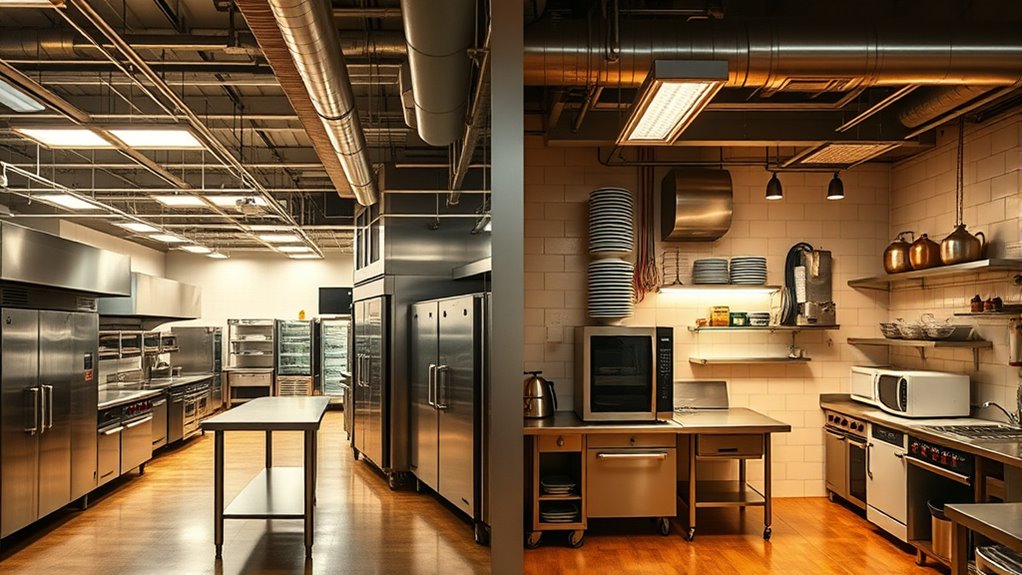
Choosing between commissary kitchens and prep kitchens often depends on their cost structures and payment models, which can profoundly affect your budget and flexibility. Commissary kitchens typically use fixed pricing models, where you pay a set fee for space and services. Prep kitchens often operate on a pay-as-you-go basis, offering more flexibility. Revenue sharing is common in some arrangements, where a portion of your sales goes to the facility. Additionally, cost management strategies can influence the overall expenses and profitability of your operation. Here are three key points:
- Fixed pricing models ensure predictable expenses but may lack flexibility.
- Pay-as-you-go models provide adaptability for fluctuating production needs.
- Revenue sharing aligns costs with your sales performance, reducing upfront costs but potentially increasing total expenses over time. Furthermore, understanding asset division laws in your jurisdiction can help you navigate potential legal considerations if your business partnership or ownership structure changes. Awareness of recent regulatory changes can also help you stay compliant and avoid unexpected costs. For example, knowledge of local licensing requirements can prevent costly violations and ensure smooth operation.
Usage and Operational Flexibility
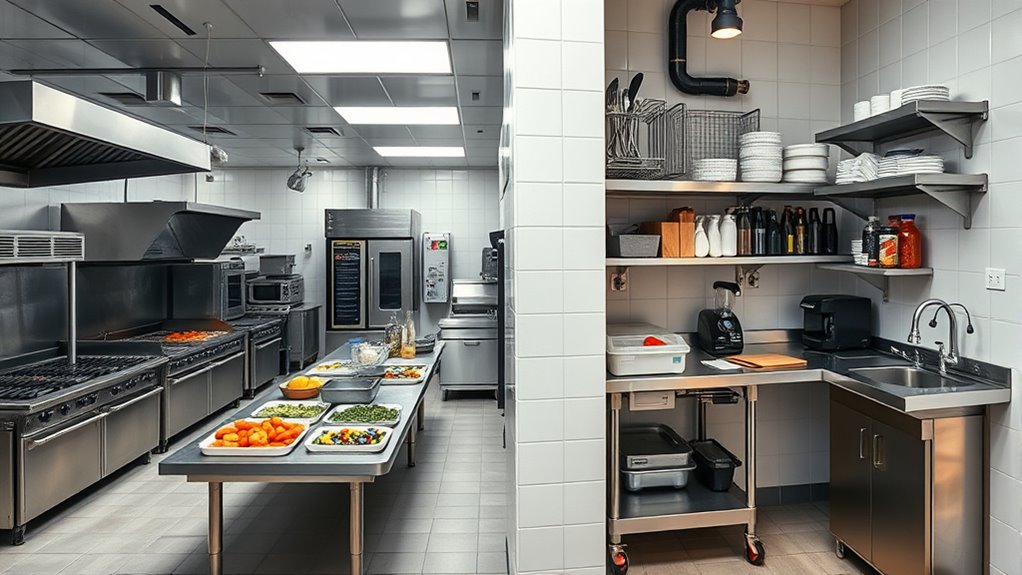
You’ll find that commissary kitchens often offer more flexible scheduling and access to equipment and space, making it easier to adapt your operations. Prep kitchens, on the other hand, tend to have more restricted hours and limited resources. Understanding these differences helps you choose the right space to meet your business’s changing needs. Additionally, considering cost factors such as monthly fees and equipment costs can influence your decision-making process. Incorporating biodiversity principles, such as sustainable practices in kitchen operations, can also contribute to environmental conservation and community well-being. For example, utilizing eco-friendly materials and waste reduction strategies aligns with environmental considerations that promote sustainability. Furthermore, awareness of location factors can impact the operational costs and accessibility of your chosen kitchen space.
Flexibility in Scheduling
Flexibility in scheduling is a key difference between commissary and prep kitchens that can considerably impact your operations. Commissary kitchens often operate on fixed hours, limiting your ability to adapt quickly. Prep kitchens, however, typically offer more flexible hours, allowing you to choose when to use the space based on your needs. This flexibility enables you to optimize your pricing models and reduce costs by working during off-peak times. Additionally, it provides opportunities for branding activities, such as hosting events or pop-ups outside standard hours. Consider these factors:
- Adjusting hours to match demand and reduce overhead.
- Aligning work schedules with promotional campaigns.
- Creating branding opportunities through flexible space use.
Flexibility can enhance efficiency and growth potential for your business.
Equipment and Space Access
Access to equipment and space considerably influences how flexibly you can operate within a kitchen. Well-designed storage solutions enable quick access to tools and ingredients, streamlining your workflow. In commissary kitchens, shared equipment often means limited availability, requiring careful planning, while prep kitchens typically offer dedicated tools that enhance efficiency. Operational flexibility also depends on clear cleaning protocols; strict routines ensure equipment stays ready for use and prevent delays. Adequate space allows you to organize your setup efficiently, reducing clutter and improving safety. Without proper access, you risk workflow disruptions, longer prep times, and compromised hygiene. Ultimately, a kitchen that provides easy equipment and space access, along with proper storage and cleaning protocols, empowers you to work seamlessly and meet your production goals.
Suitable Business Types and Scale
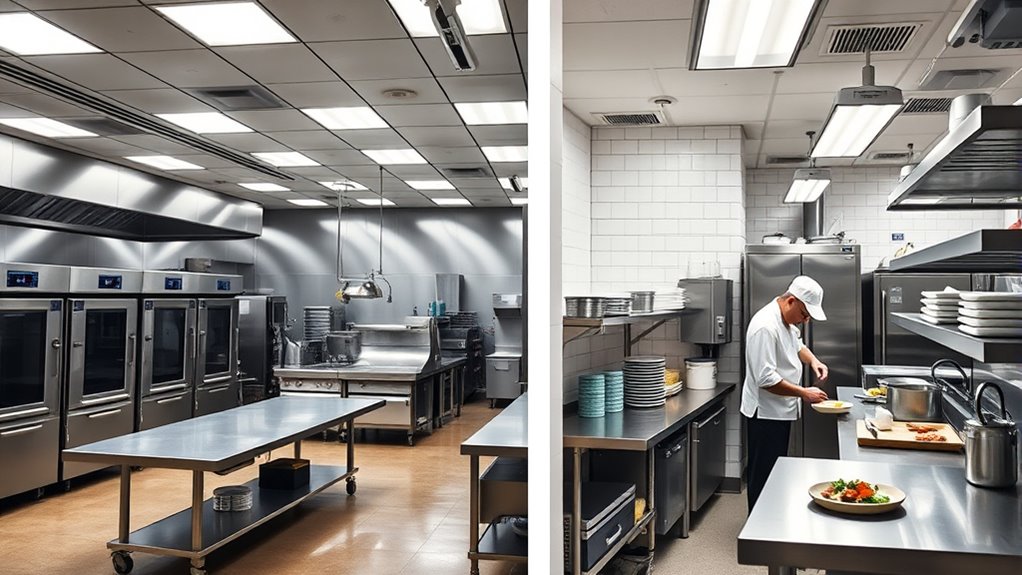
Choosing between a commissary kitchen and a prep kitchen depends largely on the size and scope of your food business. If you’re just starting or running a small operation, a prep kitchen might suit you best, offering flexibility for local markets. Larger businesses, with multiple product lines or catering needs, will benefit from a commissary kitchen’s infrastructure and licensing benefits. Consider these factors:
Start small with a prep kitchen or scale up in a commissary for growth and licensing benefits.
- Business scale—small vs. large production volume
- Branding strategies—uniformity and branding opportunities
- Marketing opportunities—expanding reach through shared commercial space
Your choice impacts your ability to grow, develop a consistent brand, and capitalize on marketing opportunities. Make sure your kitchen type aligns with your current business size and future plans for expansion.
Frequently Asked Questions
Can a Business Operate in Both Commissary and Prep Kitchens Simultaneously?
Yes, you can operate in both commissary and prep kitchens simultaneously, but you need to guarantee shared licensing and proper cross utilization. This means obtaining the right permits for each space and making sure your equipment and processes meet health regulations. By managing shared licensing carefully, you can efficiently use the same licenses across both facilities, allowing you to streamline operations and maximize your kitchen resources without legal or safety issues.
How Do Ownership Structures Differ Between Commissary and Prep Kitchens?
Imagine ownership models as the backbone of your kitchen operations. In commissary kitchens, you often see a centralized ownership structure, with legal responsibilities shared among multiple tenants or the facility itself. Prep kitchens, however, usually have individual ownership, making legal responsibilities more straightforward. Your choice impacts liability, management, and operational costs, so understanding these differences helps you navigate ownership models effectively to suit your business needs.
Are There Specific Insurance Requirements Unique to Each Kitchen Type?
You need to guarantee insurance compliance for both kitchen types, as liability coverage is essential. While general commercial policies often cover prep kitchens, commissary kitchens might require additional coverage due to shared equipment and storage. Check specific requirements from local health departments and your insurer to make sure you’re adequately protected. Tailoring liability coverage helps manage risks unique to each kitchen, ensuring you’re compliant and protected in all situations.
What Are the Common Challenges Faced When Transitioning From Prep to Commissary Kitchens?
Ever wonder what challenges pop up when moving from prep to commissary kitchens? You’ll need to focus on staff training to guarantee everyone understands new procedures and standards. Maintaining quality control becomes more complex with larger operations, requiring diligent oversight. Do you have systems in place for consistency? Shifting means adapting processes, managing larger teams, and meeting stricter regulations—all essential for smooth, successful shifts.
How Do Storage and Equipment Sharing Differ Between the Two Kitchen Types?
When it comes to storage organization and equipment allocation, you’ll find that commissary kitchens typically have dedicated, shared spaces designed for large-scale operations, making storage more centralized. Equipment is allocated based on throughput needs, often with specialized gear. In prep kitchens, storage is usually more focused on ingredients for daily use, with equipment allocated for flexibility. Understanding these differences helps optimize your workflow and resource management effectively.
Conclusion
Understanding the differences between commissary and prep kitchens helps you choose the right space to bring your culinary vision to life. Imagine stepping into a bustling, well-organized kitchen where every counter and appliance fuels your passion. Whether you need a sprawling commissary or a focused prep kitchen, knowing their unique features lets you craft your culinary journey with confidence. With the right choice, you’ll turn your ideas into delicious realities, one perfectly prepared dish at a time.
